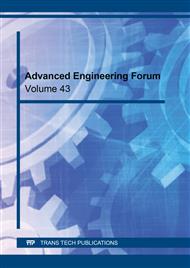[1]
Kamal Karunananda, Mitao Ohga, Ranjith Dissanayake, Sudath Siriwardane, Pang-Jo Chun; New Combined High and Low Cycle Fatigue Model to Estimate Life of Steel Bridges Considering Interaction of High and Low Amplitudes Loading. SAGE journals; Advances in structural engineering; volume 15; issue 2; November 2016; pp.287-302;.
DOI: 10.1260/1369-4332.15.2.287
Google Scholar
[2]
W. Song, X. Liu, Jie Xu, Yu Fan, Dunhau Shi, Feng Yang, Xiaolei Xia, F. Berto, Di Wan; Low-Cycle Fatigue Life Prediction of 10CrNi3MoV Steel and Undermatched Welds by Damage Mechanics Approach; Frontiers in Materials, Structural Materials, Volume 8; April 2021;.
DOI: 10.3389/fmats.2021.641145
Google Scholar
[3]
Yifeng Hu, Junping Shi, Xiaoshan Cao, Jinzju Zhi; Low Cycle Fatigue Life Assesment Based on the Accumulated Plastic Strain Energy Density; Multidisciplinary Digital Publishing Institute (MDPI) Materials; May 2021;.
DOI: 10.3390/ma14092372
Google Scholar
[4]
ISO 12106 - Standard; Metallic Materials, Fatigue Testing, Axial Strain-Controlled Mode.
Google Scholar
[5]
ASTM E606 - Standard; Test Method for Strain-Controlled Fatigue Testing.
Google Scholar
[6]
BS 7270 - Standard; Metallic Materials - Constant Amplitude Strain-Controlled Fatigue Testing.
Google Scholar
[7]
Johan Ahlstrom, Birger Karlson; Fatigue Behavior of Rail Steel - A Comparison Between Strain and Stress Loading; Chalmers University of Technology; March 2005; Wear, Volume 258; Issue 7-8; pp.1187-1193;.
DOI: 10.1016/j.wear.2004.03.030
Google Scholar
[8]
Michael Wachter, Alfons Esderts; On the Estimation of Cyclic Material Properties - Part1, Quality of known estimation methods; Material Testing; Volume 60; pp.945-952; October 2018;.
DOI: 10.3139/120.111236
Google Scholar
[9]
Luca Susmel; The Modified Manson - Coffin Curve Method in Fatigue Assessment; The University of Sheffield; In book - Multiaxial Notch Fatigue, pp.210-239; December 2009;.
DOI: 10.1533/9781845695835.210
Google Scholar
[10]
Jelena Srnec Novak, Francesco De Bona, Denis Benasciutti; Benchmarks for Accelerated Cyclic Plasticity Models with Finite Elements; Metals - Open Access Metallurgy Journal 10(6); June 2020;.
DOI: 10.3390/met10060781
Google Scholar
[11]
A. Neiderwanger, M. Ladienk, R. Lang, R. Timmers, G. Lener; On the Stability and Sensitivity of the Strain-Life Approach Using the Example of Mild Steel; Journal of Constructional Steel Research; Volume 153; p.pp.483-494; November 2018;.
DOI: 10.1016/j.jcsr.2018.10.030
Google Scholar
[12]
Shuailing Li, Xu Xie, Qin Tian, Zhicheng Zhang, Cheng Cheng; A Proposal on Ultra-Low Cycle Fatigue Damage Evaluation of Structural Steels; Theoretical and Applied Fracture Mechanics; Volume 114, August 2021;.
DOI: 10.1016/j.tafmec.2021.102973
Google Scholar
[13]
G.M. Gemilang, P.A.S. Reed, A.J. Sobey; Low-Cycle Fatigue Assessment of Offshore Mooring Chains Under Service Loading; Marine Structures Journal, Volume 76; March 2021;.
DOI: 10.1016/j.marstruc.2020.102892
Google Scholar
[14]
Akrum Abdul-Latif; Continuum damage model for low-cycle fatigue of metals: An overview; International Journal of Damage Mechanics; Volume 30 (7); p.pp.1036-1078; February 9, 2021;.
DOI: 10.1177/1056789521991620
Google Scholar
[15]
Fatigue Analysis Using ANSYS Fatigue Module and ANSYS nCode Design Life - Ansys Inc. Documentation; Ansys Mechanical Fatigue.
DOI: 10.1007/978-1-4615-0255-5_3
Google Scholar
[16]
Kasun Kariyawasam, Chinthaka Mallikarachchi; Simulation of Low Cycle Fatigue with Abaqus (FE-SAFE); Conference ACEPS; March 2015;.
Google Scholar
[17]
Raymond L. Browell, Al Hancq; Predicting Fatigue Life with Ansys Workbench; International ANSYS conference May 2-4, (2006).
Google Scholar
[18]
Prof. Grzegorz Glinka; Department of Mechanical and Mechatronics Engineering at the University of Waterloo eFatigue; The Local Stress-Strain Fatigue Method (Ꜫ-N), (2010).
Google Scholar
[19]
Ali Fatemi; Fellow of the American Society of Mechanical Engineers (ASME) University of Toledo eFatigue; Cyclic Deformation & Strain -Life (E-N) Approach - Chapter 5.
Google Scholar
[20]
Whitney A. Polling; Grain Size Effect in Micro Tensile Testing of Austenitic Steel,]; Colorado School of Mines; Master Thesis 2012; hdl.handle.net/11124/76635.
Google Scholar
[21]
ASTM E399 - Test method for linear elastic plain-strain fracture toughness of metallic materials.
Google Scholar
[22]
ASTM E647 - Method for measurement of fatigue crack growth rates.
Google Scholar
[23]
Edited by Howard E. Boyer; ASM International, The material Information society Atlas of Fatigue Curves; page 94, fig 4-12.
Google Scholar
[24]
Ricardo Branco, Jose D.M. Costa, Fernando V. Antunes, Sandra Perdigao; Monotonic and Cyclic Behavior of DIN 34CrNiMo6 Tempered Alloy steel; DOAJ Metals; April 2016; Vol. 6, no. 5; p.98; doi.org/10.3390/met6050098.
DOI: 10.3390/met6050098
Google Scholar
[25]
R.E. Weigle, R.R. Lasselle and J.P. Purtell; Experimental Investigation of the Fatigue Behavior of Thread-type Projections; Experimental Mechanics Lab. Watervliet Arsenal N.Y. May 1963; Experimental Mechanics 3, p.pp.105-111;.
DOI: 10.1007/BF02325864
Google Scholar
[26]
R. Fortfel, D. Rittel; Numerical and Statistical Method for Predicting Fatigue in Metal Cutting Tools, Advanced Topics in Mechanical Engineering Course; Technion - Israel Institute of Technology; (I. Men - Industrial Research Mentor, Applied mechanics dept. experimental team leader at Iscar Ltd. R&D).
Google Scholar
[27]
Pavol Zubko, Ladislav Pesek; Correlation between Hardness and Fatigue Properties; Key Engineering Materials; ISSN: 1662-9795 Volume 662, p.pp.197-200; September 2015;.
DOI: 10.4028/www.scientific.net/kem.662.197
Google Scholar


